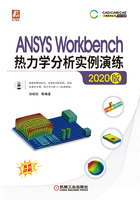
3.2 网格划分实例
以上简单介绍了ANSYS Meshing网格划分的基本方法及一些常用的网格质量评估工具,下面通过几个实例简单介绍一下ANSYS Meshing网格划分的操作步骤及常见的网格格式的导入方法。
3.2.1 网格尺寸控制

图3-47所示为模型(含流体模型),本实例主要讲解网格尺寸和质量的全局控制及局部控制,包括高级尺寸功能中Curvature、Proximity和Inflation的使用。下面对其进行网格划分。
Step1:在Windows系统下启动ANSYS Workbench,进入主界面。
Step2:双击主界面Toolbox(工具箱)中的Component Systems→Mesh(网格)选项,在Project Schematic(项目管理区)创建分析项目A,如图3-48所示。
Step3:右击项目A中的A2:Geometry,如图3-49所示,在弹出的快捷菜单中选择Import Geometry→Browse命令。

图3-47 模型

图3-48 创建分析项目A
Step4:在弹出的“打开”对话框中选择PIPE_model.stp格式文件,然后单击“打开”按钮,如图3-50所示。

图3-49 加载几何文件

图3-50 选择文件并打开
Step5:右击项目A中的A2:Geometry栏,选择Edit Geometry in DesignModeler命令,此时会弹出图3-51所示的A:Mesh-DesignModeler窗口。

图3-51 显示几何模型
Step6:填充操作。依次选择菜单栏中的Tools→Fill命令,在图3-52所示的Details View面板中进行如下操作:在Faces栏中确保模型的所有内表面被选中;单击工具栏中的 按钮生成实体。
按钮生成实体。
Step7:实体命名。右击模型树中图3-53所示的Solid,在弹出的快捷菜单中选择Rename命令,在命名区域中输入名字为pipe。
Step8:以同样的操作将另外一个实体命名为water,命名完成后如图3-54所示。
Step9:单击DesignModeler窗口右上角的 按钮,关闭DesignModeler窗口。
按钮,关闭DesignModeler窗口。
Step10:回到Workbench主窗口,如图3-55所示,单击A3(Mesh)栏,在弹出的快捷菜单中选择Edit命令。
Step11:Mesh网格划分平台被加载,如图3-56所示。

图3-52 填充

图3-53 命名操作1

图3-54 命名操作2

图3-55 载入Mesh

图3-56 Mesh平台中几何模型
Step12:选择Outline中的Project→Model(A3)→Geometry→pipe选项,在图3-57所示的Details of "pipe"面板中做如下设置。
在Material→Fluid/Solid栏中将默认的Defined By Geometry(Solid)修改为Solid。
Step13:以同样的操作,将water的Material属性从默认的Defined By Geometry(Solid)修改为Fluid,如图3-58所示。

图3-57 更改属性1

图3-58 更改属性2
Step14:右击Outline→Project→Mesh选项,在弹出的图3-59所示的快捷菜单中选择Insert→Method命令,此时在Mesh下面会出现Automatic Method命令。

图3-59 插入Method命令
Step15:在图3-60所示的Details of "Automatic method"面板中,在绘图区选择pipe实体,然后单击Geometry栏中的Apply确定选择,此时Geometry栏中显示1Body,表示一个实体被选中;在Definition→Method栏选择Tetrahedrons(四面体网格划分);在Algorithm栏选择Patch Conforming选项。
注意:当以上选项选择完毕后,Details of "Automatic Method"会变成Details of "Patch Conforming Method"-Method,以后操作都会出现类似情况,不再赘述。
Step16:右击Outline→Project→Mesh选项,在弹出的图3-61所示快捷菜单中选择Insert→Inflation命令,此时在Mesh下面会出现Inflation选项。

图3-60 网格划分方法

图3-61 网格划分方法
Step17:右击Project→Model(A3)→Geometry→pipe选项,在弹出的图3-62所示的快捷方式中选择Hide Body命令或者按〈F9〉键,隐藏pipe几何。

图3-62 隐藏几何实体
Step18:选择Outline中的 命令,如图3-63所示,在下面出现的Details of "Inflation2"面板中进行如下设置:选择water几何实体,然后在Scope→Geometry栏中单击Apply;选择三圆柱的外表面,然后在Definition→Boundary栏中单击Apply;其余选项默认即可,完成Inflation(膨胀)面的设置。
命令,如图3-63所示,在下面出现的Details of "Inflation2"面板中进行如下设置:选择water几何实体,然后在Scope→Geometry栏中单击Apply;选择三圆柱的外表面,然后在Definition→Boundary栏中单击Apply;其余选项默认即可,完成Inflation(膨胀)面的设置。
Step19:右击Project→Model(A3)→Mesh选项,此时弹出图3-64所示的快捷菜单,在菜单中选择Generate Mesh命令。

图3-63 膨胀层设置

图3-64 划分网格
Step20:此时会弹出图3-65所示的网格划分进度栏,进度栏中显示出网格划分的进度条。

图3-65 网格划分进度条
Step21:划分完成的网格如图3-66所示。

图3-66 网格模型
Step22:如图3-67所示,在Details of "Mesh"面板的Statistics中可以看到节点数和单元数以及扭曲程度。
Step23:如图3-68所示,将物理参照改为CFD,其余设置不变,划分网格。
Step24:划分完成的网格及网格统计数据如图3-69所示。

图3-67 网格数量统计

图3-68 修改物理参照

图3-69 CFD中的网格及数量
Step25:如图3-70所示,在几何绘图窗口单击Z坐标,使几何正对读者,单击工具栏中的 图标,鼠标单击几何模型上端然后向下拉出一条直线,在下端单击确定。
图标,鼠标单击几何模型上端然后向下拉出一条直线,在下端单击确定。

图3-70 创建截面
Step26:如图3-71所示,旋转几何网格模型,此时可以看到截面网格。
Step27:如图3-72所示,单击右下角Sec tion Plane面板中的 图标,此时可以显示截面网格的完整网格。
图标,此时可以显示截面网格的完整网格。

图3-71 截面网格

图3-72 截面完整网格显示
Step28:如图3-73所示,在Details of "Mesh"面板中将Size Function选项改为On:Proximity and Curvature后,划分完成后的网格。

图3-73 截面完整网格显示
Step29:单击Meshing平台上的“关闭”按钮,关闭Meshing平台。
Step30:返回到Workbench平台,单击工具栏中的 按钮,在弹出来的“另存为”对话框中输入名字为PIPE_Model,单击“保存”按钮。
按钮,在弹出来的“另存为”对话框中输入名字为PIPE_Model,单击“保存”按钮。
3.2.2 扫掠网格划分
本实例主要讲解通过扫掠网格的映射面划分的使用,下面对其进行网格剖分(见图3-74)。

Step1:启动ANSYS Workbench,进入主界面。
Step2:双击主界面Toolbox(工具箱)中的Component Systems→Mesh(网格)选项,即可在Project Schematic(项目管理区)创建分析项目A,如图3-75所示。

图3-74 模型

图3-75 创建分析项目A
Step3:右击项目A中的A2:Geometry,如图3-76所示,在弹出的快捷菜单中选择Import Geometry→Browse。
Step4:如图3-77所示,在弹出的“打开”对话框的文件类型栏中选择STEP格式;选择PIPE_SWEEP.stp格式文件,然后单击“打开”按钮。

图3-76 加载几何文件

图3-77 选择文件名
Step5:双击项目A中的A2:Geometry栏,此时会弹出图3-78所示的A:Mesh-DesignModeler平台,单击 按钮。
按钮。
Step6:此时将生成图3-79所示的几何实体。

图3-78 A:Mesh-DesignModeler平台

图3-79 几何模型
Step7:单击DesignModeler平台右上角的 按钮,关闭DesignModeler平台。
按钮,关闭DesignModeler平台。
Step8:回到Workbench主窗口,如图3-80所示,单击A3:Mesh栏,在弹出的快捷菜单中选择Edit命令。
Step9:Mesh网格划分平台被加载,如图3-81所示。

图3-80 载入Mesh

图3-81 Mesh平台中几何模型
Step10:右击Model(A3)→Mesh选项,在弹出的图3-82所示的快捷菜单中选择Insert→Method命令,此时在Mesh下面会出现Automatic Method命令。
Step11:在图3-83所示的Details of "Automatic Method"面板中进行如下操作:在绘图区选择1实体,然后单击Geometry栏中的Apply确定选择,此时Geometry栏中显示1Body,表示一个实体被选中;在Definition→Method栏选择Sweep(扫掠);在Src/Trg Selection栏选择Manual Source选项;在Source栏中确保一个端面被选中,单击 生成网格。
生成网格。
Step12:右击Model(A3)→Mesh选项,弹出图3-84所示的快捷菜单,在菜单中选择Generate Mesh命令。

图3-82 插入Method命令

图3-83 网格划分方法

图3-84 划分网格
Step13:此时会弹出图3-85所示的网格划分进度栏,进度栏中显示出网格划分的进度条。

图3-85 网格划分进度条
Step14:划分完成的网格如图3-86所示。

图3-86 网格模型
Step15:如图3-87所示,在Details of "Mesh"面板的Statistics中可以看到节点数和单元数以及扭曲程度。

图3-87 网格数量统计
Step16:如图3-88所示,插入一个Sizing尺寸控制命令,并将网格大小设置为5.e-003m。

图3-88 设置体网格大小
Step17:划分完成的网格及网格统计数据如图3-89所示。

图3-89 CFD中的网格及数量
Step18:单击Meshing平台上的关闭按钮,关闭Meshing平台。
Step19:返回到Workbench平台,单击工具栏中的 按钮,在弹出的“另存为”对话框中输入名字为PIPE_SWEEP,单击“保存”按钮。
按钮,在弹出的“另存为”对话框中输入名字为PIPE_SWEEP,单击“保存”按钮。
3.2.3 多区域网格划分

图3-90所示为某三通管道模型,本实例主要讲解多区域方法的基本使用,对于具有膨胀层的简单几何生成六面体网格,在生成网格的时候,多区扫掠网格划分器自动选择源面。下面对其进行网格剖分。
Step1:启动ANSYS Workbench,进入主界面。
Step2:双击主界面Toolbox(工具箱)中的Component Systems→Mesh(网格)选项,即可在Project Schematic(项目管理区)创建分析项目A,如图3-91所示。

图3-90 三通管道模型

图3-91 创建分析项目A
Step3:右击项目A中的A2:Geometry,如图3-92所示,在弹出的快捷菜单中选择Import Geometry→Browse。
Step4:如图3-93所示,在弹出的“打开”对话框中选择MULTIZONE.stp文件,然后单击“打开”按钮。

图3-92 加载几何文件

图3-93 选择文件
Step5:双击项目A中的A2:Geometry栏,此时会弹出图3-94所示的DesignModeler平台。

图3-94 显示几何模型
Step6:单击DesignModeler平台右上角的 按钮,关闭DesignModeler平台。
按钮,关闭DesignModeler平台。
Step7:回到Workbench主窗口,如图3-95所示,单击A3:Mesh栏,在弹出的快捷菜单中选择Edit命令。
Step8:Mesh网格划分平台被加载,如图3-96所示。

图3-95 载入Mesh

图3-96 Mesh平台中的几何模型
Step9:右击Model(A3)→Mesh选项,在弹出的图3-97所示的快捷菜单中选择Insert→Method命令,此时在Mesh下面会出现Automatic Method命令。

图3-97 插入Method命令
Step10:在图3-98所示的Details of "MultiZone"-Method面板中进行如下操作。
在绘图区选择Solid实体,然后单击Geometry栏中的Apply确定选择,此时Geometry栏中显示1Body,表示一个实体被选中;在Definition→Method栏选择MultiZone(多区域);在Element Order栏选择Use Global Setting;在Src/Trg Selection栏选择Manual Source选项;在Source栏中确保图示的四个面被选中;其余选项保持默认即可。
注意:当以上选项选择完毕后,Details of "Automatic Method"会变成Details of “MultiZone”-Method,以后操作都会出现类似情况,不再赘述。

图3-98 网格划分方法
Step11:右击Model(A3)→Mesh选项,此时弹出图3-99所示的快捷菜单,在菜单中选择Generate Mesh命令。
Step12:划分完成的网格如图3-100所示。

图3-99 划分网格

图3-100 网格模型
Step13:右击Model(A3)→Mesh→MultiZone选项,在弹出的图3-101所示的快捷菜单中选择Delete命令,删除MultiZone节点。
Step14:右击Model(A3)→Mesh命令,在弹出的图3-102所示的快捷菜单中选择Insert→Inflation命令,此时在Mesh下面会出现Inflation选项。

图3-101 删除MultiZone命令

图3-102 网格划分方法
Step15:单击Outline中的 选项,如图3-103所示,在下面出现的Details of "Infla tion"面板中进行如下设置:选择Solid几何实体,然后设置Scope→Geometry为1Body;选择圆柱和长方体的外表面,然后设置Definition→Boundary为6Faces;其余选项默认即可,完成Inflation(膨胀)面的设置。
选项,如图3-103所示,在下面出现的Details of "Infla tion"面板中进行如下设置:选择Solid几何实体,然后设置Scope→Geometry为1Body;选择圆柱和长方体的外表面,然后设置Definition→Boundary为6Faces;其余选项默认即可,完成Inflation(膨胀)面的设置。

图3-103 膨胀面设置
Step16:右击Model(A3)→Mesh选项,此时弹出图3-104所示的快捷菜单,在菜单中选择Generate Mesh命令。
Step17:划分完成的网格如图3-105所示。

图3-104 划分网格

图3-105 膨胀层网格划分
Step18:单击Meshing平台上的“关闭”按钮,关闭Meshing平台。
Step19:返回到Workbench平台,单击工具栏中的 按钮,在弹出的“另存为”对话框中输入名字为MULTIZONE,单击“保存”按钮。
按钮,在弹出的“另存为”对话框中输入名字为MULTIZONE,单击“保存”按钮。